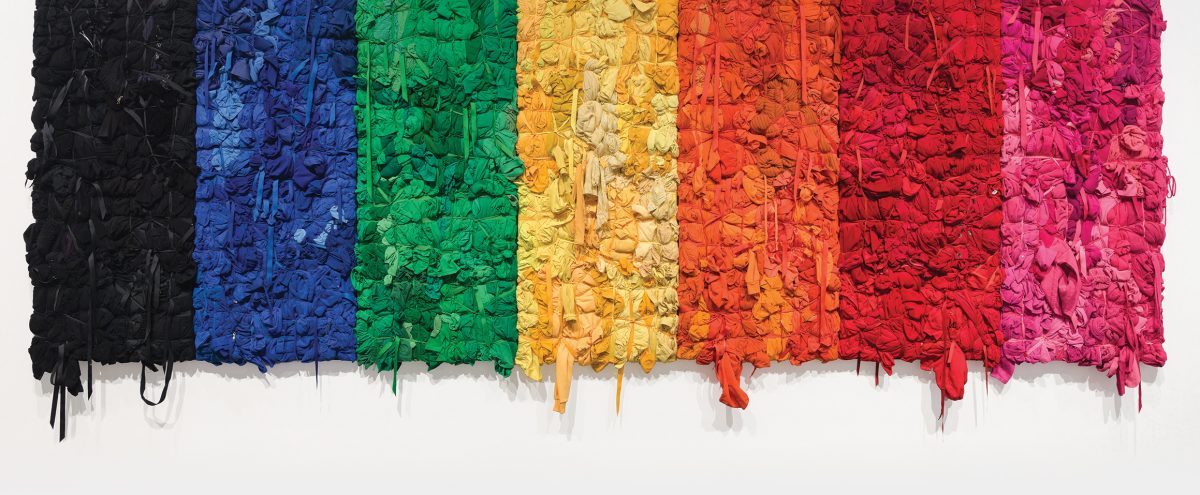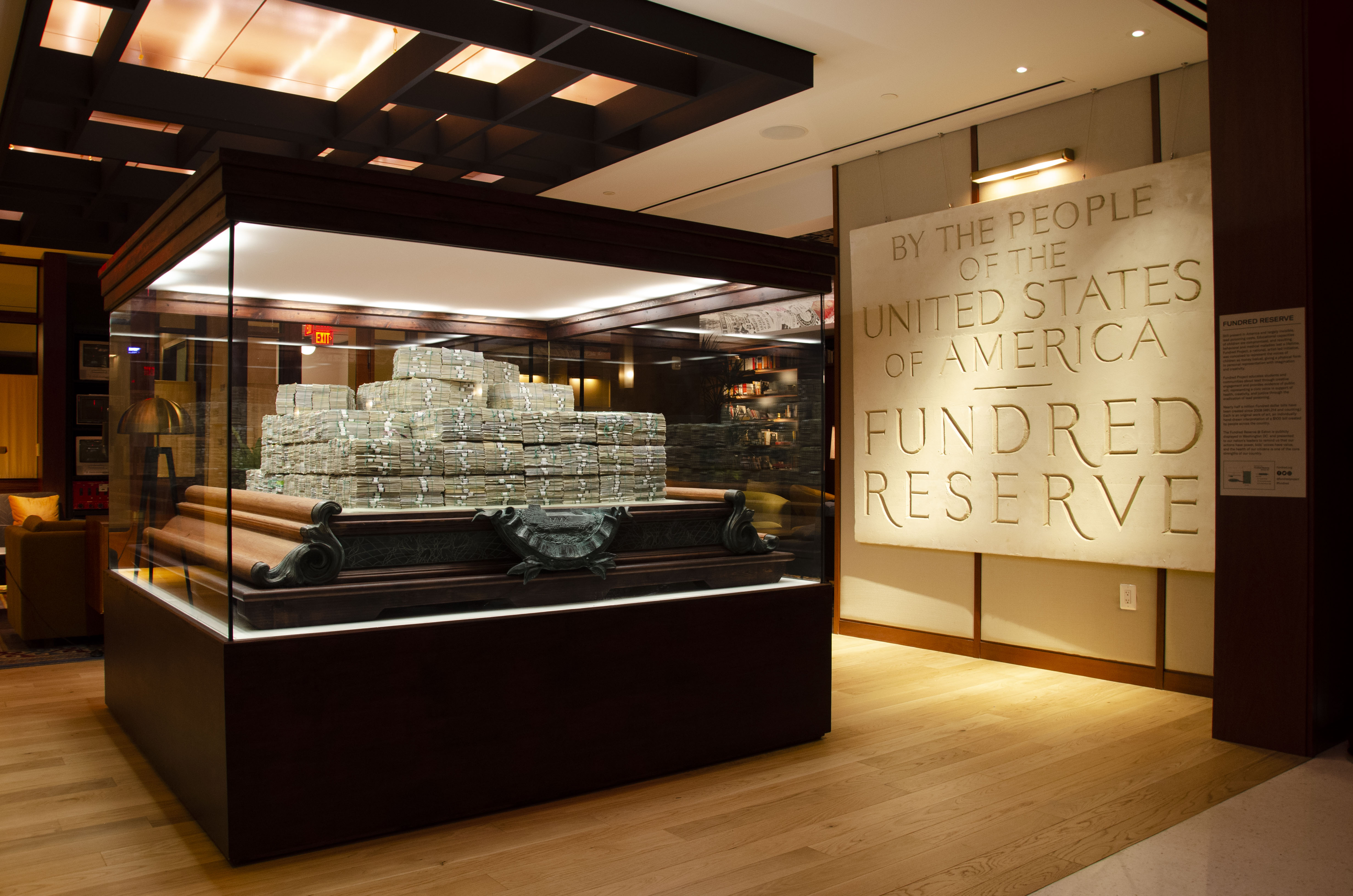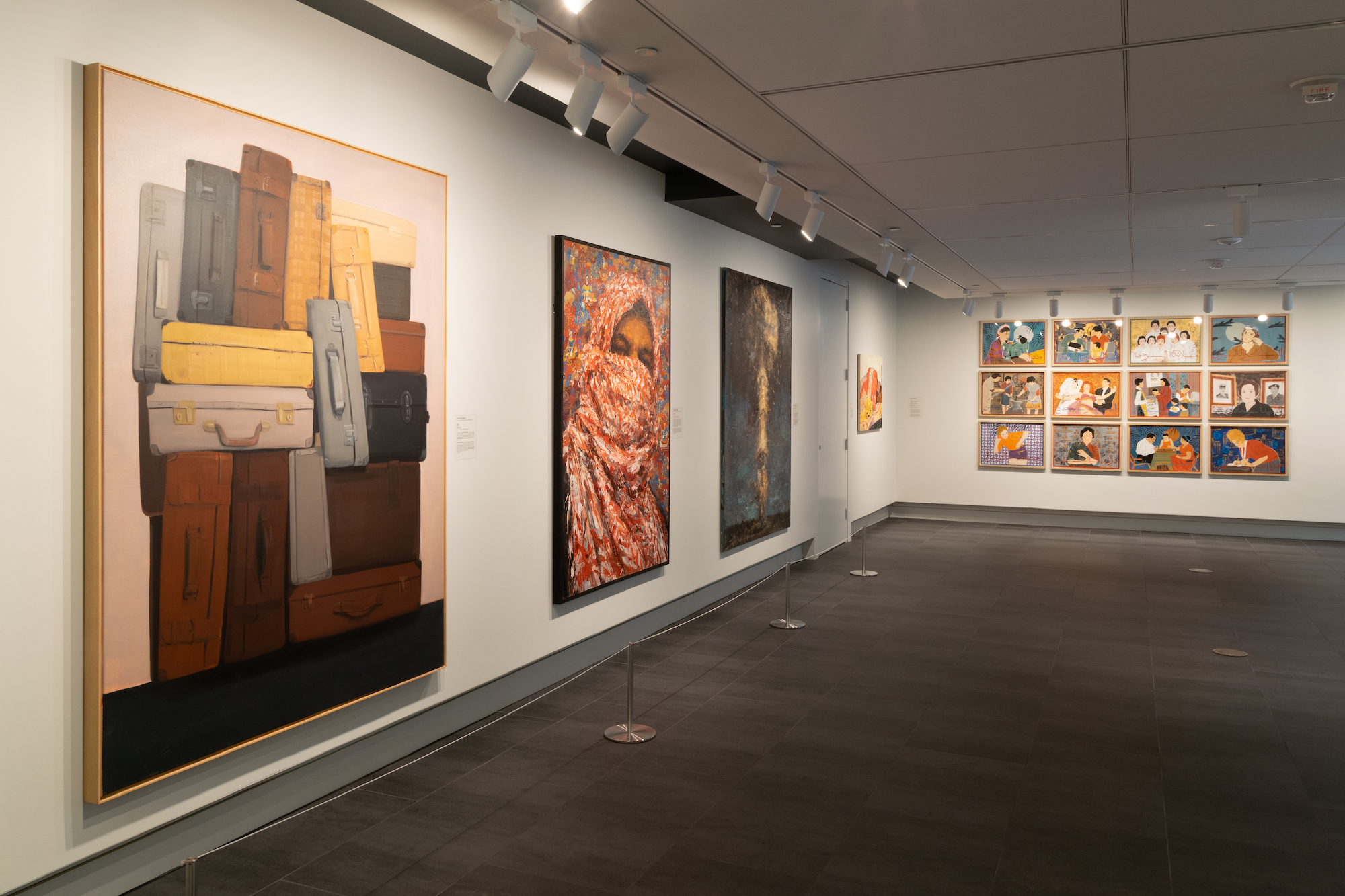The new Middle East Institute Art Gallery, which opened its doors with a lively reception on September 14, certainly holds promise. It’s a handsome (if modest) space, in an enviable location: occupying a slice of the ground floor of the recently renovated Institute, it’s a mere block from Dupont Circle and within easy walking distance of several other art galleries. It seems to be generously funded—judging, at least, from the elegant fixtures, the crisply designed materials, and the musicians, dancers, and calligrapher who performed at the opening. And its dedication to Middle Eastern art conveniently coincides with a general embrace of Arab modernist and contemporary art by both the art market and art historical scholarship over the past 15 years. In short, the new gallery feels propitious.
Ultimately, though, it’s the art on view that really matters, and in that sense the gallery’s first show only partly satisfies. Curated by Rose Issa, an established London-based gallerist and curator, and rooted in a 2017 show that she put together for the Beirut Art Fair, Arabicity/Ourouba (through November 22) features works by 17 artists. They variously claim ties to Egypt, Lebanon, Syria, Iraq, Palestine, Israel—and Morocco, echoing the Institute’s inclusive definition of the Middle East. Most of the artists are mid-career and have shown internationally; notably, nearly half are now based at least partly in Western Europe or the Americas. And while most are represented by a single work, there’s nevertheless a diversity of media on display: Paintings predominate, but the exhibition also features two videos, several photographs, and a handful of assemblages.

Installation view of Arabicity/Ourouba
Several pieces stand out. In Sharif Waked’s “Chic Point: Fashion for Israeli Checkpoints,” a 2003 video piece, models strut on a mock runway, bearing costumes that suddenly unzip or peel away from the abdomen—and thus anticipate the dehumanizing searches of Palestinians crossing the Green Line. It’s at once impish, cheeky, and plaintive: mistrust sublimated into haute couture. In Hassan Hajjaj’s “Saida in Blue,” a young woman wears a hijab and kerchief dotted with motifs from a Louis Vuitton handbag. Piety and modesty intermingle promiscuously with consumerist display, as the woman seems to smile playfully beneath her veil—and a hand-painted background and a frame derived from a used tire cleverly complicate the sleek familiarity of the corporate imagery.
Potent, too, is Said Baalbaki’s “Trunks I,” a 2011 painting of a compact stack of suitcases. An allusion to the artist’s own displacement—born in Lebanon, Baalbaki fled violent conditions there and moved to Berlin—it is also a quiet study in stasis and balance, as the blocky shapes comprise a stout form. Emblems of travel are thus recast, intriguingly, as a monument, and manage to link Baalbaki to a tradition of abstraction that stretches back to Rothko.

Anas Albraehe, untitled, acrylic on canvas
Some of the other works, though, are less impressive. For one thing, much of the work engages in a rather dated dialogue with old tropes—Abstract Expressionism, Pop, Minimalism, and the Pictures Generation—rather than with more relevant, recent, or global artistic idioms. Moreover, there is also an unfortunate but recurring tendency towards heavy, literal metaphor. In a work by Batoul S’himi, for instance, we see a pressure cooker inscribed with a map of the Arab world. It’s a one-liner, virtually as effective when described as when seen, that makes one long for the more complex depth of a Mona Hatoum.
Similarly, the only piece by Khalil Rabah is a two-foot-long model airplane whose fuselage is painted with a fictional company title: United States of Palestine Airlines. It’s a wry allusion, of course, to the longstanding Palestinian yearning for statehood and freedom of motion. But it feels simplistic on both a conceptual and an aesthetic level. And perhaps that’s unsurprising, for it was originally one of many elements in a more ambitious installation, which coolly mimicked the slick bureaucracy of an airline office. Displayed by itself, though, the plane disappoints.

Khalil Rabah, “United States of Palestine Airlines, London Office,” model airplane
Unfortunately, that’s not the only questionable curatorial decision. Reportedly, Issa initially conceived of the show as a body of work by artists from territories that have recently experienced upheaval—a rather odd criterion, given the accompanying interest in probing the possibility of an Arab essentialism. (“Is there,” asks Issa, in a brief catalog essay, “a common cultural link?”) Also odd, in this direction, is the fact that most of the works were made before the Arab Spring and the Syrian Civil War: that is, before a hugely consequential series of developments in the region. Issa’s lens, as a result, feels selective and dated.
And complications only multiply when we note that there is not a single artist from the Gulf in the show. Is that mere chance? Or is it a residue of the fact that the earlier, 2017 iteration of this show was staged in Lebanon, and foregrounded Lebanese artists? Or is it somehow related to the fact that the Institute’s largest donors in 2016–17 were the UAE and Saudi Arabia—countries which clearly do not want to be perceived, regardless of their centrality to the Arab world, as experiencing upheaval? (For what it’s worth, the Institute’s donor policy says that MEI is “not affiliated or aligned with any domestic or foreign political party, institution or government” and that it “retains full intellectual independence for itself and its scholars as relates to the content of its work.”)
Or is it perhaps something even simpler? In the accompanying brochure, no fewer than 10 of the captions include the phrase “Courtesy of Rose Issa Projects.” Issa, to her credit, has long been a committed voice in the promotion and display of Arab art. But such an open reliance upon her established stable of artists feels myopic, and even self-serving. Casting a wider net might have resulted in a less arbitrary selection, and in an even more compelling show.

Batoul S’himi, “Arab World Under Pressure,” aluminum pressure cooker
In its online mission statement, the gallery claims that it “seeks to showcase the very best in contemporary and modern art, photography and video from Morocco to Afghanistan.” Due to its idiosyncratic and partial cast, slightly dated work and murky curatorial logic, this show doesn’t quite accomplish that. Hopefully, though, these limitations can be transcended in upcoming shows. Any gallery attached to a larger institution, of course, will have to navigate some complex decisions. But at least the sizable and visibly engaged crowd on hand at the opening demonstrated that there is a real regional enthusiasm for recent Middle Eastern and Arab art. Here’s hoping that the initial sense of promise will give way to even more nuanced, transparent, and ambitious programming in the near future.
Arabicity/Ourouba is on view at the Middle East Institute Gallery through Nov. 23. For more info, visit the Middle East Institute’s website.
Featured image: Installation view of Arabicity/Ourouba. All images courtesy of Middle East Institute.






